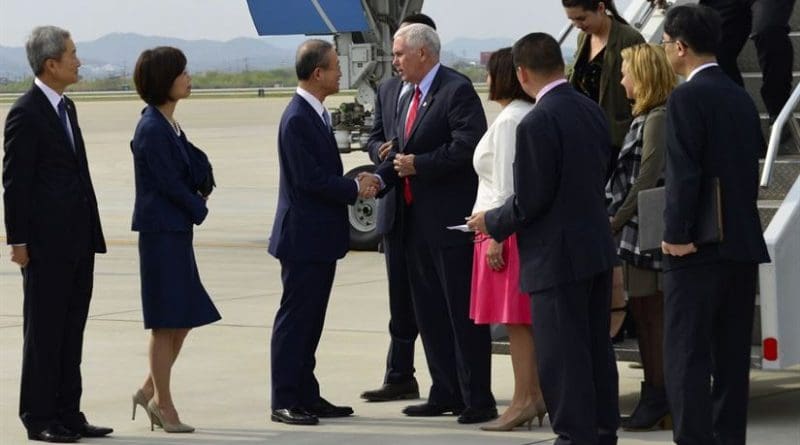15 Candidates, Trump Posters, And A Conservative Divide In Korea – OpEd
By Mitchell Blatt*
South Korea’s presidential election is coming up on May 9, and some supporters of break-away conservative candidates are using Donald Trump to make campaign appeals. Like most events that feature Donald Trump, it is chaotic.
Former president Park Geun-hye, who was the leader of the conservative Saenuri Party, was impeached in December, removed from office on March 10, and arrested March 31.
Her party quickly rebranded itself as the Korean Liberty Party, and Hong Jun-pyo, governor of South Gyeongsang Province, which borders Busan, was nominated as the KLP’s candidate for president in a primary that featured a paucity of strong conservative candidates. Former UN Secretary Ban Ki-moon briefly flirted with the idea of running for president as the conservative standard bearer, but apparently 2017, the year when the party is emerging disgraced from a major corruption scandal, just didn’t attract many takers. Hong is polling between 7-13 percent in recent polls.
Already Korean conservatives were divided by disaffection with Park. Even before the scandal was uncovered, the Baerun Party emerged as a group of conservatives in the National Assembly who didn’t strongly support Park. Now it includes 33 legislators and draws 3-4 percent of the vote.
Still, over a month after Park was removed from office, the grassy square outside of City Hall Station is filled with older conservatives waving Korean and American flags while bemoaning what they consider “a conspiracy to communize the South under the pretext of the unjustifiable presidential impeachment,” as a sign says.
Representing the Saenuri supporters who still can’t let go of impeachment is Rep. Cho Won-jin, a legislator who has newly constituted a party with the name Saenuri and says he will “punish those who led her impeachment and seek Park’s release.”
But even the new Saenuri Party isn’t enough to satisfy all never-let-go conservatives. So on April 19, outside Sinchon Station, a university district nearby Yonsei and Ihwa universities lined with bars and restaurants, flag-waving middle-aged and senior Koreans campaigned for Nam Jae-jun, who served as leader of the National Intelligence Service under Park.
Nam, who represents the Unification Korea Party (or Patriotic Korea Party), said in 2013, “Unification is possible in 2015. Let’s die together to bring about the unification of our land under liberal democracy.”
Besides waving American flags, his small group of supporters (no more than four dozen in a photo) displayed signs associating themselves with Donald Trump and U.S. Vice President Mike Pence.
“Make America Great Again by One Free Korea,” a sign said. (“One Free Korea” appears to be yet another interpretation of their party name.)
Trump’s aggressive style appeals to older Korean conservatives, especially those who still support Park. At a pro-Park rally on March 1, I noticed messages about the “lying media.” The press is a “weapon of mass murder,” one sign said.
Meanwhile, on the liberal and moderate side, there is a divide between the traditional liberals of the Minjoo Party, led by Moon Jae-in, and the reformist neo-liberals of the People’s Party, led by Ahn Cheol-soo. The People’s Party also appears to attract some conservatives who are either disenchanted with conservative leadership or who are voting strategically to stop Moon, who was an aide to controversial president Roh Myun-hoo. Roh was beloved by liberals but hated by conservatives for continuing Kim Dae-jung’s Sunshine Policy towards North Korea and publicly defending “anti-Americanism” in a national TV interview. After securing his party’s nomination, Ahn surged briefly, besting Moon in three polls, but recent polls have stabilized with Moon polling in the high 30’s or low 40’s, and Anh polling in the low-to-mid 30’s.
One notable thing about Korean campaign posters is that they all include the number of the candidate on the ballot. In Korea, candidates are listed on the ballot by representation in the legislature (largest party to smallest), and candidates for parties with no representatives are listed by lottery. That puts Moon at number one, Hong at number two, and Ahn at number three on the ballot.
This is different with the U.S., where each state does its own thing with the ballot. Many states list in proportional order either to their last presidential election or statewide elections. Minnesota lists in reverse proportional order (for major party candidates). Some states, like Ohio, randomly order ballots differently in voting areas across the state. Scholarship is divided about if and to what degree being number one on the ballot helps the candidate in a national election.
*Mitchell Blatt has been based in China and Korea since 2012. A writer and journalist, he is the lead author of Panda Guides Hong Kong guidebook and has contributed to outlets including The National Interest, National Review Online, Acculturated, and Vagabond Journey. Fluent in Chinese, he has lived and traveled in Asia for three years, blogging about his travels at ChinaTravelWriter.com. You can follow him on Twitter at @MitchBlatt.

